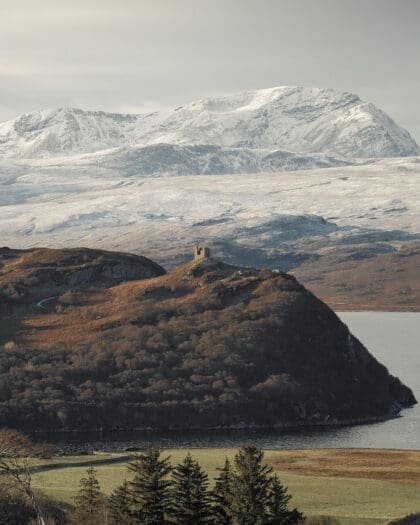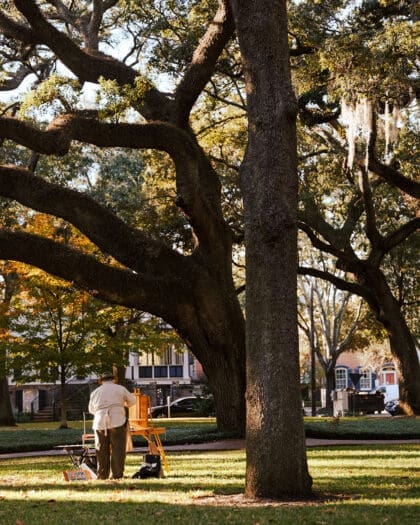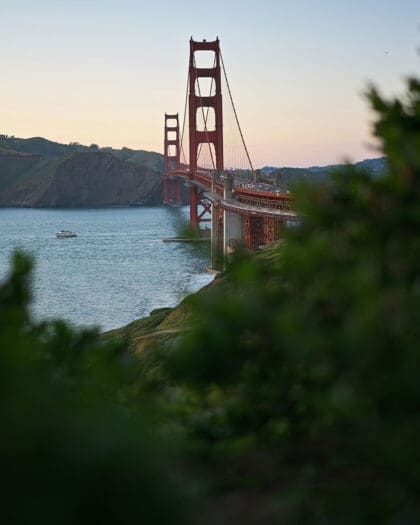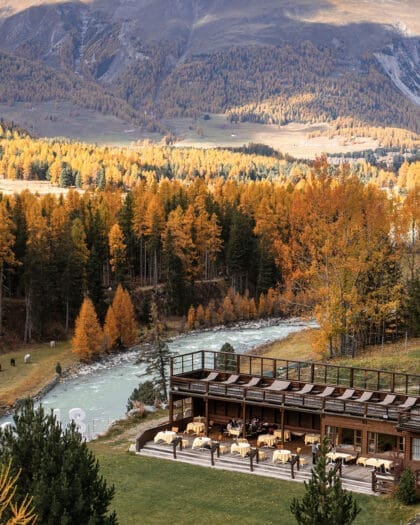
How the travel industry is striving for a new, ‘better’ normal
It only took two years to dismantle the customs of decades of global travel, but is the industry emerging from the pandemic now doing things for the better?
If you really listened during those first strange days of lockdown in 2020, the most impactful sound was… silence.
Not just no cars on the road, but no jets flying overhead. Stories emerged from around the world, of how less pollution was allowing people in India to see the Himalayan peaks for the first time in years, or of how the lack of boat traffic in Venetian canals finally rendered the water clear enough to see fish. Cruise ships stopped churning up shallow harbours, and crowds stopped jostling each other for glimpses of the Mona Lisa or the Trevi Fountain. The planet could, finally, breathe again.
And so did we. We sat back, and saw how we had carelessly been consuming the world: our desire to see everything and be everywhere was negatively impacting those experiences we were hell bent on ticking off our lists. A seed was planted for both travellers and the travel industry itself: could this be an opportunity to change our habits? Could we harness this moment to make positive change and do things better?
In a recent global report* on what tourism will look like in this brave new world, UN Secretary-General Antonio Guterres declared, “There’s now a chance to rethink how tourism interacts with our societies, other economic sectors and our natural resources and ecosystems; to measure and manage it better; to ensure the fairer distribution of its benefits and to advance the transition towards a carbon-neutral and more resilient tourism economy.”
And at the supposedly defining moment of COP26 in Glasgow last year, governments made pledges on important climate change issues including deforestation, methane emissions, and more, with commitments to potential cuts of 2.2 gigatonnes of carbon dioxide – equivalent to the emissions of Germany, Japan and the UK combined.
But after two years of being grounded, the industry is battling to survive and consumers are thirsty for a change of scene. As most restrictions such as pre-departure and post-arrival testing and Passenger Locator Forms have been dropped in the UK and other destinations around the world, our appetite for travel is returning.
Operators like TUI report a 19% higher rise in customers booking a holiday for summer 2022, compared to summer 2019. And while that is still largely to short haul and European destinations, the recent opening of borders in countries such as Australia, New Zealand, Vietnam, Cambodia and Malaysia will mean long haul travel won’t be far behind, just as flight bookings to the USA jumped when they opened their borders in November 2021 (at the time, Virgin Atlantic reported a 91% boost, while BA saw a sevenfold increase in flight searches).
With our zest for exploring stronger than ever, what’s the industry doing to change for good?
Are hotels keyed in?
Brenda Collin, executive VP of Europe at Preferred Hotels & Resorts, believes the pandemic has forced hotels to think more creatively: “Now more than ever, guests are seeking exclusive, individualised experiences, outdoor activities, and intimate dining opportunities, and this has been a fantastic opportunity for hotels to get creative and cater to the individual versus the collective.”
This has also had an effect on sustainability. She believes “travellers are increasingly seeking getaways that give back in impactful ways, ensuring they don’t have a negative impact on local communities and the surrounding environment on their next holiday.”
A new tourism industry initiative which emerged as a result of the pandemic, the Future of Tourism coalition, has set out several guiding principles for sustainable travel – aimed at the travel industry but also useful for travellers to check whether their provider is playing ball – including choosing quality of visitation over quantity of visitors, redefining economic success to favour metrics that can benefit the destination, like small business development and distribution of income rather than contribution to GDP, and protecting local natural, scenic and cultural assets.
Long-stays can also aid the impact on the community; Julian Hudson, GM of The Fellows House in Cambridge, part of the Curio Collection by Hilton, points out, “this year we are anticipating the return of business travel, and that our long-stay lifestyle apartment offering will be a refreshing alternative to hotels guests may previously have used.”
This means either single guests, or groups, such as families, can spend longer in the destination and treat the property as a home-from-home, as these long-stay offerings tend to have facilities such as kitchens and washing machines.
Elsewhere, one of the most noticeable ways hotels have adapted to this brave new world is by elevating their cleaning game to an art form. Anxious not to be thought of as germ-ridden, brands have gone above and beyond to signal to guests that their environments are spotless, something that shows no sign of changing.
Michael Northcott, editor of Hotel Owner magazine, says “hoteliers are already very well-versed in health and safety matters, possibly more so than many other sectors, and have been taking all the measures they feel are appropriate.” Hence initiatives like bidding bye-bye to the breakfast buffet, the sealing of fully cleaned rooms between check-ins, or an increase in contactless tech.
“There’s a great deal of interest among hoteliers in technological innovations to help increase safety and also guests’ confidence,” says Northcott. To minimise social interaction, many hotels like Moxy, Marriott’s boutique side hustle, now offer online check-in, or at terminals.
Four Seasons has its own ‘Chat App’, where you can communicate with a concierge without doing it face-to-face. Some brands, like Hilton and Accor, have developed digital ‘keys’, where you open your room via your phone; in addition, Accor lets guests talk to hotel staff via WhatsApp, and also order and pay for food and drink with their smartphone. And hip brand citizenM’s new app will allow guests to control their room’s TV, lights, blinds, temperature and more from their phone.
The Future of Tourism coalition can help travellers to check whether their provider is playing ball
Tour operators planning ahead
One thing travellers quickly realised at the start of the pandemic, when trying to get refunds from airlines, hotels, or tour operators, was the importance of having booked through a reliable, honest company. And now that travel is taking off again, tour operators can be worth their weight in gold when it comes to navigating ever-changing destination entry rules. Tour ops can also arrange bespoke, tailor-made experiences and trips that mean every traveller gets exactly the holiday they want.
“During Covid, many new clients realised the benefits of using a travel advisor – essentially a trusted resource and an experienced navigator,” says Tom Marchant, co-founder of luxury travel company Black Tomato. “The desire for travel to be more meaningful and rejuvenating is at the fore more than ever,” she adds, “and as such we’re seeing clients seeking extraordinary, bespoke and often life-affirming experiences becoming a more significant part of travel planning.”
Cat Jones, co-founder of slow travel company Byway Travel agrees: ‘”Personalisation will be big this year, and concierge-like support will be essential.”
She also believes slow travel, tech and sustainability will be high on travellers’ lists. “People will be looking for companies who carbon-label their trips, so they can assess the impact before they book. And techwise, contactless will lead the way to seamless transit. Train travel is also likely to rise, thanks to its lower carbon footprint, and the fact you can immerse yourself for longer in a journey, which itself then becomes part of the holiday.”
The sustainable initiatives taking off for air travel
Possibly airlines’ biggest challenge is how to lower their carbon emissions; it’s estimated that around 2.4% of global CO2 emissions come from aviation and that, together with other pollutants, such as the water vapour from contrails, means the industry is responsible for around 5% of global warming. Already, however, several airlines offer the opportunity for passengers to contribute to carbon-offsetting, including British Airways, easyJet, Qantas, and Delta . In addition, British Airways’ CEO Sean Doyle recently reiterated the company’s commitment to sustainability, explaining that its fleet has already switched to sustainable aviation fuel (SAF) which is 35% more efficient, with a target of powering at least 10% of their flights by SAF by 2030, and an ultimate goal to get to carbon net zero by 2050.
The European Federation for Transport and Environment recommends other measures, including changing flight paths so that planes fly at lower altitudes, which would have the effect of avoiding contrail formation. Other future strategies could include looking at whether planes could use electric batteries, or use hydrogen fuel made with renewable power.
In terms of other sustainable practices airlines have been adopting, many already are starting reducing things like use of plastic even before the pandemic. On June 5 2019, United Airlines flew from Chicago to LAX on what it billed was the most “eco-friendly commercial flight in the history of aviation”, using biofuel, recyclable or compostable serviceware, and recyclable cups, reducing their average 65lbs of waste per flight to just 14lb, generated by passengers from what they brought on board.
The previous month, a Qantas flight from Sydney to Adelaide did something similar, replacing over 1,000 single-use plastic items with biodegradable alternatives. Since then, Emirates, SAS and Qantas have introduced onboard recycling facilities to sort aluminium, glass, paper and plastic products before landing, and just before the pandemic, BA announced plans to remove a quarter of a billion items of single use plastic before the end of 2020, a goal it still plans to work towards.
A turning point for tourist attractions?
We can all agree that having to battle through crowds, or interminable queues, just to get to stand in front of a priceless painting, artefact or monument, is something we’d rather live without.
Various destinations have become victims of their own success, thanks to their history, food scene, or even just a reputation as a place to party (we’re looking at you, Venice, Barcelona and Prague). “Tourism is like any other industry: it needs to be regulated and managed locally to prevent negative impacts,” says Justin Francis, CEO of UK-based tour operator Responsible Travel, which has produced its own guide to the issue of overtourism.
One benefit of the pandemic was that people couldn’t go anywhere at all, allowing cities and towns to breathe a sigh of relief, but now that the tourist industry is starting to flourish again, its economy still needs to be stimulated.
Of course, much of the onus has to be on the traveller to avoid visiting a country, city, or sight at the busiest possible time – choosing to go in low season, for example, or to a lesser-known part of the world – but destinations themselves are starting to fight back.
The easiest way to reduce visitors is to start charging for entry, something cities such as Venice are planning to do this year. Adopting a ‘tourist tax’ – adding a small sum to the cost of a hotel stay – is also popular, and is already enforced in the likes of France and Austria, and will be introduced in Edinburgh later this year.
And some museums and sights are still enforcing timed entry to purposefully avoid overcrowding, from London’s Tate Modern to the Catacombs in Paris. Perhaps unfortunately, however, the industry which particularly contributed to overcrowding *cough* cruising – which involved big ships parking up in harbours and regularly releasing hundreds of passengers to flood city centres or small islands – is on the increase again.
In March, 45 additional ships entered or re-entered service, on a variety of itineraries around the world. It seems we might find ourselves battling for a view of the Mona Lisa or for a table at a beachside restaurant once again…
Illustration by Cami Ruohonen. *Euronews Travel report: Travel after 2020: what will tourism look like in our new reality?







